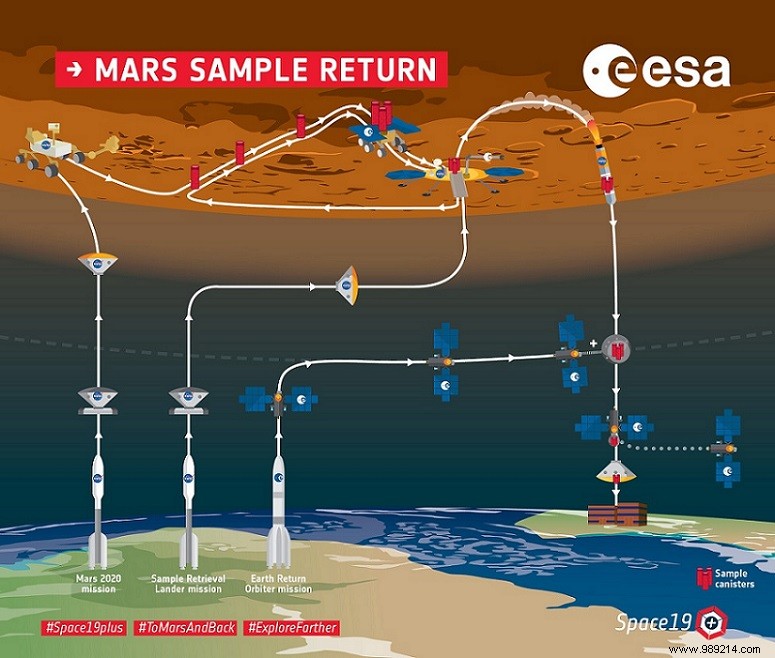Last February, NASA set its sights on the Northtop Grumman company to develop the engines that will power the rocket responsible for placing the Martian samples set aside by Perseverance into orbit. , where they can be collected to be brought back to Earth.
You know it:NASA and the European Space Agency will once again collaborate to try what has never been done:bring samples of the planet back to Earth red .
In this mission, named Mars Sample Return, it all starts with Perseverance. The main mission of the rover will be to probe the ground in search of traces of past life. It is then planned to put some rock samples under seal. These will then be left on the surface waiting to be picked up.
As a second step, probably in 2026 , NASA will send a new lander to Mars. Once there, he will deploy the Sample Fetch Rover, a small vehicle responsible for collecting the samples set aside by Perseverance. These will then be deposited in the Mars Ascent Vehicle, a small rocket that will take off in the spring 2029 to place itself in orbit around the red planet.
A probe, the Earth Return Orbiter, will collect these samples directly from orbit, before bringing them back to Earth, probably in the early 2030s .
But then, who will take care of what? To put it simply, the Sample Fetch Rover and the probe responsible for bringing the samples back to Earth will be managed by ESA and Airbus. NASA, for its part, will furnish the lander and the ascent vehicle. According to the agency, Northrop Grumman will supply the motors to lift the vehicle.

It's not Northrop Grumman's first 'Martian rodeo'. The company has already distinguished itself with the landing systems for the Pathfinder/Sojourner mission, then with the Spirit and Opportunity rovers.
For this next mission, the company will provide two solid propellant engines to support the two stages of the rocket . “It's a good propulsion system. Well understood. Good for the cold. Because it's going to be cold “, says analyst David McGrath.
This type of thruster also ages well. We know this in part thanks to the LDEF (Long Duration Exposure Facility) experiment. Launched into low Earth orbit on April 6, 1984 by the space shuttle Challenger, it was originally scheduled to be recovered eleven months later. However, a series of mission reshuffles in 1984 and 1985 followed by the Challenger disaster ultimately delayed its recovery until January 1990 by the shuttle Columbia.
“Information from LDEF and other aging studies gives us confidence that this longer than usual exposure to vacuum and cold will not be a problem “, notes the researcher.
Cold management will be one of the key elements of this phase of the mission, especially since the rocket will have less than 40 watts of power provided by solar energy to maintain its solid propellant within acceptable mission temperature ranges (ideally -20°C). To help maintain these temperatures, the rocket will have a thermal coating.
This thermal liner will also be designed to open from the top so collected Martian samples can be loaded inside their capsule. Again, the timing will be tricky. Indeed, this coating should not be open for too long to prevent temperatures from falling below acceptable levels. Thus, the integration of the samples inside may have to be done in several stages.
For liftoff, NASA requested a burn time of about 70 seconds for the first stage and about 25 seconds for the second. However, before, we will have to take off, which has never been attempted before on another planet .
Placed on its lander, the small rocket will not be able to fire its engine directly. Also, it will be necessary to launch the rocket in the air, then to light the first stage. "Basically they'll use a spring and push the rocket into the air “, emphasizes McGrath. "And since Martian gravity is one-third that of Earth, you have a bit more time before it recontacts the ground. So there is plenty of time for it to ignite . »
The vehicle's Thrust Vector Control system will then allow it to place itself on the correct trajectory.
Finally, the weather will also be a key factor for takeoff from Jezero Crater. With such precious cargo, mission leaders won't take any risks. Also, perfect control of these climatic conditions will be essential to authorize the launch.